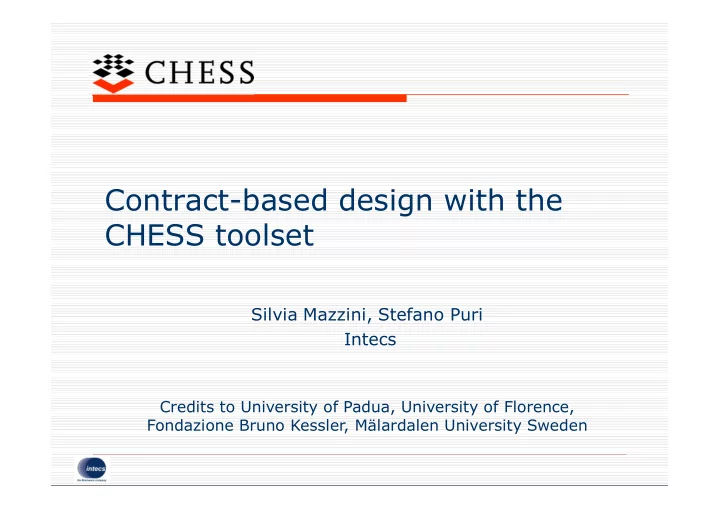

Contract-based design with the CHESS toolset Silvia Mazzini, Stefano Puri Intecs Credits to University of Padua, University of Florence, Fondazione Bruno Kessler, Mälardalen University Sweden
The CHESS Open Source Toolset Composition with guarantees for high- integrity Model based engineering embedded software component assembly CHESS Modelling Language Based upon Eclipse, UMLPapyrus Separation of concerns Functional vs non functional Among design views Component based development Specialized to capture the non functional properties of components • Real Time • Dependability/Safety Correctness by construction Extra functional properties are: • asserted and verified at design time • preserved/guaranteed at run time CHESS is available as Eclipse Polarsys Project 2 https://www.polarsys.org/chess/
Main R&D pojects AMASS Architecture-driven, Multi-concern and Seamless Assurance and Certification of Cyber-Physical Systems 3
The CHESS Modeling Language Standard Unified Standard profile for Standard profile for Modeling Language System (and Modeling and Analysis of Requirements) Modeling Real-Time and Embedded Systems Imports subsets of standard languages avoid redundancy Integrates and extends standard fix semantic variation OMG languages points In addition, it provides a profile for Dependability and Contract-based modelling 4
The CHESS methodology– high level view System Model using the CHESS modelling language Model transformations Contract-based analysis Dependability analysis Real-time analysis Iteration on the model: Model transformations Feasibility, composition propositions… … 5
Major Capabilities and Analysis Tools Model consistency checks Failure Propagation Analysis and FMEA/FMECA generation State-based Dependability Analysis (by DEEM integration) Contract-based Design and Analysis (by OCRA, nuXmv and XSAP integration) Safety case generation (by OpenCert integration) Real time analysis (by MAST integration) • Schedulability and end-to-end response time analysis (with multi-core support) • Back propagation of analysis results Domain specific needs • IMA support • AUTOSAR support Code generation for Ada (and C) Support for run-time monitoring 6
CHESS Design Views RequirementView SystemView Contract- SoftwareView (PIM) Dependability based View View DeploymentView Real Time View AnalysisView PSMView 7
Bird Flight on Views SW Model - static Requirements System Model SW Model - dynamic Deployment Analysis View 8
Software View - CHESS component model Component Reusable functional unit, decorated with extra-functional constraints Platform Independent Container and Connector Implementation of the extra-functional properties of components Factorized implementation Platform Specific (PSM View) 9
Using Contracts in CHESS Use Contracts for System Engineering for lower levels of decomposition to be consistent with the higher ones to formalize conditions for element verification and integration for reuse of abstractions of available components Contract-based design benefits compositional reasoning Reusable component co-engineering separation of concerns systematic virtual integration and verification protection of intellectual property 10
Contracts-based approach Contracts composed of Assumptions and Guarantees Assumptions are properties expected to be satisfied by the environment Guarantee is a statement that holds as long as the environment satisfies the assumption Contract Assumption Guarantee The conceptual models System Functional Architecture Step-wise (vertical) refinement process System Logical Architecture with formal verification of contract refinement System Physical Architecture within each conceptual model Software Architecture and trace relation between corresponding entities at different conceptual levels 11
Step-wise refinement Formal verification If the refinement steps are proven correct, then any implementation of the leaf components that satisfies the component contracts can be used to implement the system … it is a top-down process A … but is also enables bottom-up exploitation of libraries of reusable certified components B C D E Reusable component 12
Contract-based View Requirements formalization Usage of LTL Collect formalized requirements as contracts Assumption and guarantee properties Assign contracts to system/software/HW platform components Enable contract-based analysis 13
Contracts modelling support Requirements Contracts Design Verification Definition Definition AMASS Contracts modelled as a special kind of constraint, owning assumptions and guarantees constraints 14 14
Contract-based analysis support Requirements Contracts Verification Design Definition Definition Seamless integration with OCRA, nuXmv and XSAP tools from FBK Verification of contracts refinements Verification of contracts composition FTA from contracts specification Verification of contracts against component behavior specification 15
Thank you for your attention QUESTIONS?
Recommend
More recommend